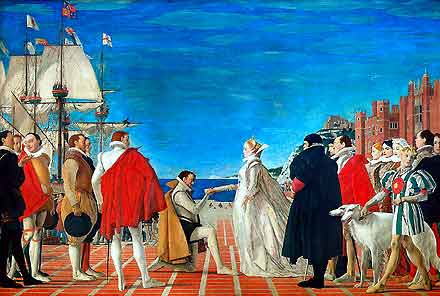Queen Elizabeth commissions Raleigh to sail for America
© 2007
Armchair Travel Co. Ltd. - This page may be used for non-commercial purposes
ONLY!
![]()

[ Play
Narrated and Animated Movie ! ] Before Queen Elizabeth, kneels one of her favourite courtiers, Sir Walter Raleigh. It is 1584, and following the death of his kinsman Sir Humphrey Gilbert, with whom he had made an unsuccessful earlier voyage to the Americas, Raleigh was awarded by the queen a new patent to 'discover new lands, take possession of them in the name of the queen, and to hold them for six years.
An expedition, planned and financed by Raleigh, was sent, which brought back enthusiastic reports of the country and the native peoples. They also brought back samples of tobacco. Raleigh, whom the Queen would not permit to leave her presence at court, sent another expedition, which annexed the territory of Virginia - naming it in compliment to the Queen. The expedition was in the short term a failure, though in the next reign, in 1607, when Raleigh lay a prisoner in the Tower of London, he did finally see the establishment of a colony in Virginia. It was the small beginning out of which grew the New England colony.
This is one of eight monumental canvases commissioned in 1927 to fill the vacant spaces on the walls of St Stephen's Hall. The idea of this scheme was conceived by a committee including Lord Peel, Lord Crawford (Chairman of the Fine Arts Commission) and the Speaker of the House of Commons - at that time J.H. Whitley. The subjectmatter and artists were chosen by Sir Henry Newbolt, the unifying theme being 'The Building of Britain', during the eight centuries from King Alfred to Queen Anne. The result is an unusual attempt to produce in the 1920s High Art of the sort which was understood by the Victorian artists of the 19th-century Palace, of Westminster, but which was no longer popular or perhaps well understood.
[ Virtual
Tour ] [ Main Topics
Index ]

Additional Information on
Queen Elizabeth commissions Raleigh to sail for America
Explore-Parliament.net: Advanced Category Search
Keyword Categories:
_Queen
_Royal_Family
_Woman
_Person
_Man
_Topic_Elizabeth_I_
_Artist_Lawrence
_Event_Historical
_Object_Painting
_Object_Artwork
_Setting_England
_Elizabeth_I_